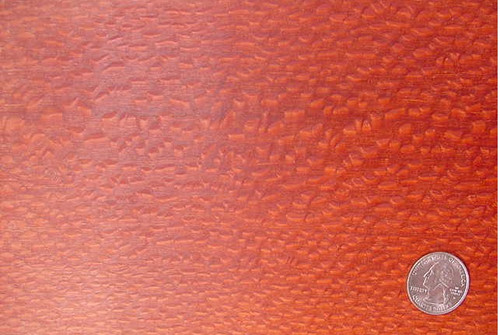Product Description
LUMBER SURFACED ON 2 SIDES SOLD BY THE SQUARE FOOTCommon Name(s): Lacewood, Brazilian Lacewood, South American Lacewood Scientific Name: Panopsis spp. (P. rubescens, P. rubellens, and P. sessilifolia)
Distribution: Tropical South America
Tree Size: 50 ft (15 m) tall, 2-3 ft (.6-1.0 m) trunk diameter
Average Dried Weight: 33 lbs/ft3 (530 kg/m3)
Specific Gravity (Basic, 12% MC): .43, .53
Janka Hardness: 710 lbf (3,160 N)* *Estimated hardness based on specific gravity Modulus of Rupture: No data available
Elastic Modulus: No data available Crushing Strength: No data available Shrinkage:No data available
Color/Appearance: Has a very conspicuous flecking that gives this wood its namesake. The wood itself is a reddish brown with grey or light brown rays, which result in a lace pattern when quartersawn. Like other woods that exhibit the strongest figure in quartersawn pieces, (such as Sycamore), Lacewood has the most pronounced figure and displays the largest flecks when perfectly quartersawn; this is due to the wood’s wide medullary rays, whose layout can be seen the clearest when looking at the endgrain.
Grain/Texture: Has a fairly coarse and uneven texture due to the difference in densities between the regular wood tissue and the rays. The grain is usually straight.
Endgrain: Diffuse-porous; small to medium pores in tangential rows; solitary and tangential multiples of 2-3; deposits in heartwood occasionally present; growth rings indistinct; very wide rays easily visible without lens; parenchyma banded, diffuse-in-aggregates.
Rot Resistance: Lacewood is rated as non-durable and is also susceptible to insect attack.
Workability: Overall a fairly easy wood to work with, taking glues, stains, and finishes well; though there may be some difficulty in planing, with tearout occurring. Some species of lacewood can also have a moderate blunting effect on cutting edges.
Odor: No characteristic odor.
Allergies/Toxicity: Although there have been no adverse health effects reported for Lacewood in the Panopsis genus, several other genera in the Proteaceae family have been reported to cause eye and skin irritation. See the articles Wood Allergies and Toxicity and Wood Dust Safety for more information. Pricing/Availability: Prices for Lacewood vary depending upon the specific species, but tend to be medium to high for an imported wood.
Sustainability: This wood species is not listed in the CITES Appendices or on the IUCN Red List of Threatened Species. Common Uses: Veneer, cabinetry, fine furniture, musical instruments (guitars), and turned objects.
Comments: The name “Lacewood” is used very loosely and can be applied (and misapplied) to a number of different wood species. In its vaguest sense, the term “lacewood” is used to describe any wood that displays figuring that resembles lace. Attempts to identify a specific board macroscopically may be difficult.
Two Australian species, Northern Silky Oak (Cardwellia sublimis), and Southern Silky Oak (Grevillea robusta) can both look very similar, and are sometimes sold as Australian Lacewood. Additionally, Leopardwood (Roupala spp.) looks similar, but tends to be slightly darker brown, and is significantly heavier.








